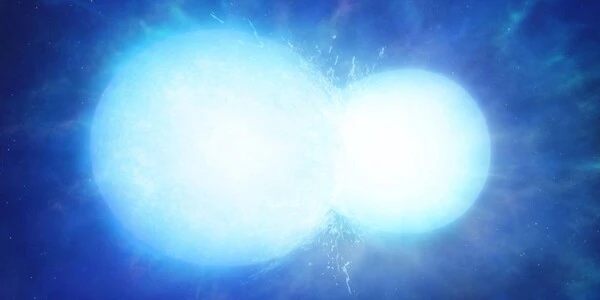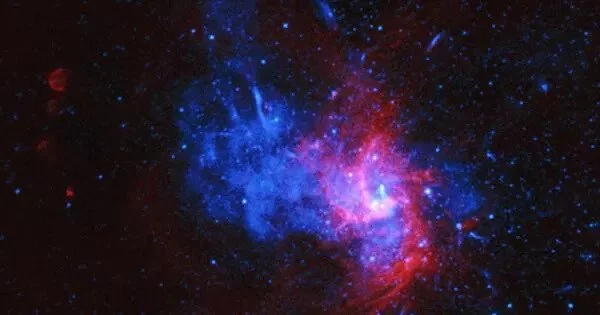When stars, such as our Sun, run out of fuel, they contract to form white dwarfs. Sometimes such dead stars resurrect in a super-heated explosion, resulting in a fireball of X-ray radiation. For the first time, a research team led by FAU has been able to observe such an explosion of X-ray light.
“It was to some extent a fortunate coincidence, really,” explains Ole König from the Astronomical Institute at FAU in the Dr. Karl Remeis observatory in Bamberg, who has published an article about this observation in the journal Nature, together with Prof. Dr. Jörn Wilms and a research team from the Max Planck Institute for Extraterrestrial Physics, the University of Tübingen, the Universitat Politécnica de Catalunya in Barcelona und the Leibniz Institute for Astrophysics Potsdam.
“These X-ray flashes last only a few hours and are almost impossible to predict, but the observational instrument must be pointed directly at the explosion at exactly the right time,” explains the astrophysicist.
The instrument in this case is the eROSITA X-ray telescope, which is currently located 1.5 million kilometers from Earth and has been surveying the sky for soft X-rays since 2019. On July 7, 2020, it detected strong X-ray radiation in an area of the sky that had been completely inconspicuous four hours before. When the X-ray telescope surveyed the same spot in the sky four hours later, the radiation had vanished. As a result, the X-ray flash that had previously completely overexposed the center of the detector had to have lasted less than eight hours.
One way to picture these proportions is to think of the Sun being the same size as an apple, which means Earth would be the same size as a pin head orbiting around the apple at a distance of 10 meters.
Jörn Wilms
Theoretical research predicted such X-ray explosions more than 30 years ago, but they were never directly observed until now. These X-ray fireballs occur on the surface of stars that were once comparable in size to the Sun before using up most of their hydrogen and later helium fuel deep inside their cores. These stellar corpses shrink until only “white dwarfs” remain, which are roughly the size of Earth but have a mass comparable to that of our Sun.
“One way to picture these proportions is to think of the Sun being the same size as an apple, which means Earth would be the same size as a pin head orbiting around the apple at a distance of 10 meters,” explains Jörn Wilms.
Stellar corpses resemble gemstones
On the other hand, if you were to shrink an apple to the size of a pin head, this tiny particle would retain the apple’s comparatively large weight. “A teaspoon of matter from the inside of a white dwarf easily has the same mass as a large truck,” Jörn Wilms continues. Because these smoldering stars are primarily composed of oxygen and carbon, we can compare them to massive diamonds the size of Earth floating around in space. These precious gem-shaped objects are so hot that they glow white. However, the radiation is so weak that it is difficult to detect from Earth.

Unless, of course, the white dwarf is accompanied by a star that is still burning, and when the white dwarf’s enormous gravitational pull draws hydrogen from the shell of the accompanying star. “Over time, this hydrogen can accumulate to form a few meters thick layer on the surface of the white dwarf,” explains FAU astrophysicist Jörn Wilms.
The enormous gravitational pull generates enormous pressure in this layer, which causes the star to relight. In a chain reaction, the layer of hydrogen is blown off, resulting in a massive explosion. The X-ray radiation from an explosion like this is what hit the eROSITA detectors on July 7, 2020, resulting in an overexposed image.
“We were able to analyze the overexposed image in more detail during a complex process to gain a behind-the-scenes view of an explosion of a white dwarf, or nova, using the model calculations we originally drew up while supporting the development of the X-ray instrument,” Jörn Wilms explains. According to the findings, the white dwarf has approximately the mass of our Sun and is thus relatively large. The explosion produced a fireball with a temperature of approximately 327,000 degrees Fahrenheit, making it approximately sixty times hotter than the Sun.
Because these novae run out of fuel quickly, they cool quickly and the X-ray radiation weakens until it eventually becomes visible light, which reached Earth half a day after the eROSITA detection and was observed by optical telescopes. “A seemingly bright star then appeared, which was actually the visible light from the explosion, and it was so bright that it could be seen on the night sky by the naked eye,” Ole König explains.
Previously observed “new stars” such as this one were named “nova stella,” or “new star,” due to their unexpected appearance. Since these novae are only visible after the X-ray flash, it is very difficult to predict such outbreaks and it is mainly down to chance when they hit the X-ray detectors. “We were really lucky,” says Ole König.
















